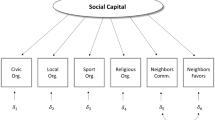Abstract
Social capital has attracted increasing attention in recent years. We use county-level and individual survey data to study how Wal-Mart affects social capital. Estimates using several proxies for social capital—such as club membership, religious activity, time with friends, and other measures—do not support the thesis that “Wal-Mart destroys communities” by reducing social capital. We measure exposure to Wal-Mart two ways: Wal-Marts per 10,000 residents and Wal-Marts per 10,000 residents aggregated over the years since 1979 to capture a more cumulative “Wal-Mart Effect.” We find that the coefficients on Wal-Mart’s presence are statistically insignificant in most specifications.
Similar content being viewed by others
References
Basker, E. (2005a). Job creation or destruction? Labor-market effects of Wal-Mart expansion. Review of Economics and Statistics, 87(1), 174–183.
Basker, E. (2005b). Selling a cheaper mousetrap: Wal-Mart’s effect on retail prices. Journal of Urban Economics, 58(2), 203–229.
Basker, E. (2007a). The causes and consequences of Wal-Mart’s growth. Journal of Economic Perspectives, 21(3), 177–198.
Basker, E. (2007b). When good instruments go bad: a reply to Neumark, Zhang, and Ciccarella (Working Paper 0706). University of Missouri-Columbia.
Baum, C., Schaffer, M., & Stillman, S. (2003). Instrumental variables and GMM: estimation and testing. Stata Journal, 3(1), 1–31. Boston College Department of Economics Statistical Software Components S425401.
Baum, C., Schaffer, M., & Stillman, S. (2007). IVREG2: stata module for extended instrumental variables/2SLS and GMM estimation. Stata Journal, 3(1), 1–31.
Bowles, S., & Gintis, H. (2002). Social capital and community governance. Economic Journal, 112, F419–F436.
Brueckner, J. K., & Largey, A. G. (2006). Social interaction and urban sprawl (Working Paper No. 1843). CESifo. Available online: http://ssrn.com/abstract=946914.
Carden, A. (2006). Institutions and Southern development: lynching as a signal of insecure property rights. Unpublished PhD Dissertation, Washington University in Saint Louis.
Coleman, J. S. (1988). Social capital in the creation of human capital. American Journal of Sociology, 94, S95–S120. Supplement: Organizations and Institutions: Sociological and Economic Approaches to the Analysis of Social Structure.
Dube, A., Lester, W., & Eidlin, B. (2007). Firm entry and wages: impact of Wal-Mart growth on earnings throughout the retail sector (Working Paper No. iirwps-126-05). Institute of Industrial Relations.
Durlauf, S. N. (2002b). On the empirics of social capital. Economic Journal, 112, F459–F479.
Fishman, C. (2006). The Wal-Mart effect: how the world’s most powerful company really works—and how it’s transforming the American economy. New York: Penguin Press.
Fukuyama, F. (1999). The great disruption. New York: Simon and Schuster.
Glaeser, E. L., Laibson, D., & Sacerdote, B. (2002). An economic approach to social capital. Economic Journal, 112, F437–F458.
Goetz, S. J., & Rupasingha, A. (2006). Wal-Mart and social capital. American Journal of Agricultural Economics, 88(5), 1304–1310.
Goetz, S. J., & Swaminathan, H. (2006). Wal-Mart and county-wide poverty. Social Science Quarterly, 87(2), 211–226.
Greene, W. (2004). Fixed effects and bias due to the incidental parameters problem in the Tobit model. Econometric Reviews, 23, 125–147.
Gruber, J., & Frakes, M. (2006). Does falling smoking lead to rising obesity? Journal of Health Economics 25(2), 183–197.
Hausman, J., & Leibtag, E. (2004). CPI bias from supercenters: does the BLS know that Wal-Mart exists? (NBER Working Paper No. 10712).
Hausman, J., & Leibtag, E. (2005). Consumer benefits from increased competition in shopping outlets: measuring the effect of Wal-Mart (NBER Working Paper No. 11809).
Levitt, S. D., & Dubner, S. J. (2005). Freakonomics: a rogue economist explores the hidden side of everything. New York: William Morrow.
Microsoft Corporation (2004). Microsoft MapPoint 2004: North America. Microsoft Corporation.
Neumark, D., Zhang, J., & Ciccarella, S. (2005). The effects of Wal-Mart on local labor markets (NBER Working Paper No. 11782).
North, D. C. (1981). Structure and change in economic history. New York: W.W. Norton & Co.
North, D. C. (1990). Institutions, institutional change, and economic performance. Cambridge: Cambridge University Press.
North, D. C. (2005). Understanding the process of economic change. Princeton: Princeton University Press.
Putnam, R. (2000). Bowling alone. New York: Simon and Schuster.
Rupasingha, A., Goetz, S. J., & Freshwater, D. (2006). The production of social capital in US counties. Journal of Socio-Economics, 35, 83–101.
Sobel, R. S., & Dean, A. M. (2008, in press). Has Wal-Mart buried Mom and Pop?: The impact of Wal-Mart on self-employment and small establishments in the United States. Economic Inquiry.
Smith, D. H. (1997). The rest of the nonprofit sector: grassroots associations as the dark matter ignored in prevailing ‘Flat Earth’ maps of the sector. Nonprofit and Voluntary Sector Quarterly, 26, 115–131.
Staiger, D., & Stock, J. H. (1997) Instrumental variables Regression with weak instruments. Econometrica 65(3), 557–586.
Stone, K. E. (1997). Impact of the Wal-Mart phenomenon on rural communities. In Increasing the underst anding of public problems and policies—1997. Chicago: Farm Foundation. Available online: http://www.seta.iastate.edu/retail/publications/10_yr_study.pdf. Accessed December 28, 2006.
US Census Bureau (1990). Census of population and housing. Washington, DC: US. Department of Commerce, Economics and Statistics Administration, Bureau of the Census. Downloaded from the National Historical Geographical Information System (NHGIS).
US Census Bureau (1992). Census of governments: Volume 2. Washington, DC: US. Department of Commerce, Economics and Statistics Administration, Bureau of the Census.
US Census Bureau (1997). Census of retail trade. Washington, DC: US. Department of Commerce, Economics and Statistics Administration, Bureau of the Census.
US Census Bureau (2000). Census of population and housing. Washington, DC: US. Department of Commerce, Economics and Statistics Administration, Bureau of the Census. Downloaded from the National Historical Geographical Information System (NHGIS).
Wooldridge, J. (2002). Economic analysis of cross-section and panel data. MIT Press.
Author information
Authors and Affiliations
Corresponding author
Rights and permissions
About this article
Cite this article
Carden, A., Courtemanche, C. & Meiners, J. Does Wal-Mart reduce social capital?. Public Choice 138, 109–136 (2009). https://doi.org/10.1007/s11127-008-9342-6
Received:
Accepted:
Published:
Issue Date:
DOI: https://doi.org/10.1007/s11127-008-9342-6




